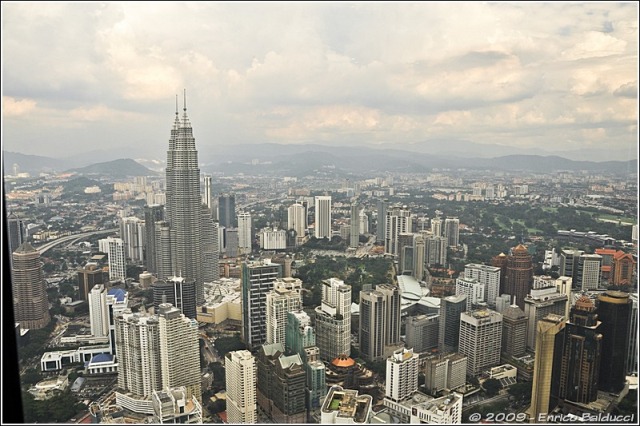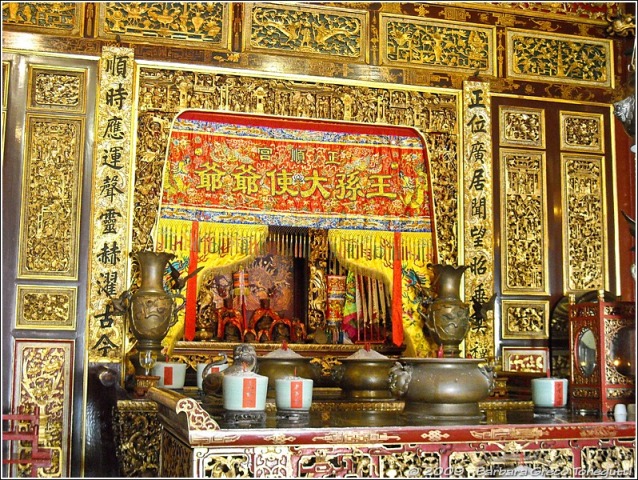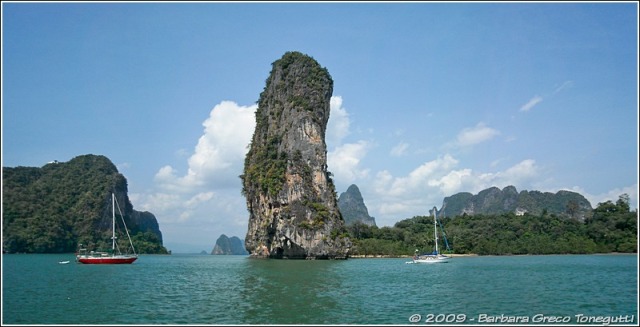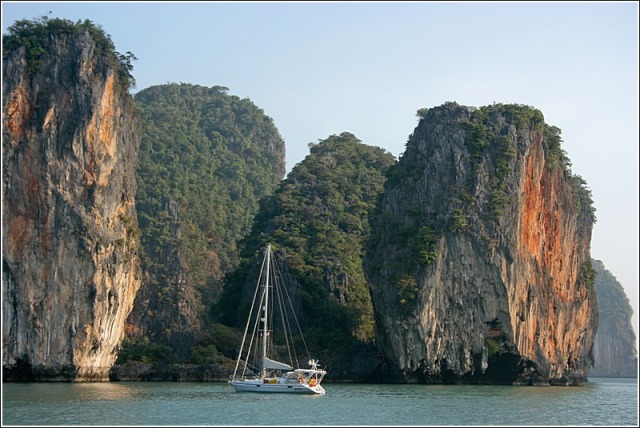|

| |

The next "official" stopover is in Phucket,
which we will reach at the end of nearly one month of "free cruising" along the
shores of Malaysia up to the island of Langkawi, to then enter Thailand (everybody
is a bit nervous because several days will pass between our exit from Malaysia
and our official entry into Thailand, which can only take place in Phucket).
04/12/2008
MALAYSIAN PIRATES?...
No doubt, Malaysian pirates were, and maybe still are, a reality, but the
country is modern and wealthy: for the first time (apart from the obvious
exception of Australia) we see tourist locations that are well kept and full of
local tourists.


The romantic Port Dickson yacht club, in a
perfect colonial style
In fact our first contact with the country when we went to Fort Dickson for the
entry formalities, after having moored Shaula in the nearby nice, colonial-style
marina, was rather disappointing, but we soon acknowledged the contrasts of this
country, where the ultra-modern Kuala Lumpur, with a city centre which is
dominated by the Petronas twin towers and rivals with Singapore, coexists with
the colonial-era buildings of Melaka (the ancient capital) and Georgetown, both
recently appointed "World Heritage" sites by UNESCO.


The main road across the historycal block of
Melaka
Also in this Country there have been subsequent occupations by the Portuguese,
then the Dutch and finally the British, each lasting about 150 years, and traces
of the three cultures are still visible, together with the influence of the many
Indian and Chinese inhabitants.
A cheerfully industrious, kind and discreet people, seldom oppressing the
tourists with their offers and taking "no" as an answer (and THAT is seldom
found elsewhere!).


The Petronas towers loom over a skyscraper
scenery in downtown Kuala Lumpur


(left) Kuala Lumpur's "National Monument" and
the "National Moscque" (right)

Just out of town, the Hindu temple at the Batu
caves
Unfortunately, the sailing north along the Malaysian coast has not been very
pleasant, with the usual mixture of tropical squalls, head-winds and short,
choppy seas.

Shaula beats against the short swell of the
Malacca straits
We had to make-do with only two
stopovers, one in Port Dickson, from where we went to visit Melaka (Malacca) and
Kuala Lumpur, and later Georgetown.

The Georgetown city hall


The Khoo Kongsi (Khoo clanhouse) in Georgetown


Rickshaws are a common sight in this part of
the world

It wouldn't be actually needed, but Enrico
enjoys hand-steering the boat
A radical change in Langkawi: change of landscape, with complex, dramatic
sceneries, little islands, plenty of anchorages and navigable rivers. Change in
the weather, with long periods of very light rain and spells of burning sunshine.
Change in the shopping facilities, because the place is a huge duty-free for the
locals: if you need a camera, or chocolate, or cheap liquors, there is plenty of
choice, but if you need bread...
Change also in the visible percentage of Malay people and also in the percentage
of women dressed according to Muslim practices, although this is mostly limited
to a head scarf while tight jeans and a t-shirt worn over a long-sleeved black
sweater are almost standard. Women do not seem limited in any way, they do drive
cars and ride mopeds, they walk in the streets and do work, also in jobs
requiring contact with other people. In general, it looks like a fairly relaxed
interpretation of Islam.

Sunset in Pulau Dajang Bunting, a small island
near Langkawi
A couple of days ago, we went with a local boat along a navigable river where we
saw sea-eagles, bat-filled caves and a strange-looking crab, called "horseshoe
crab" whose upper shell reminds closely that of fossils we have seen so often in
museums.
Pity that the many rivers and the strong currents make the waters rather murky
and unattractive for diving.

These boats, equipped with an automotive engine
and a straight prop-shaft are very common in this area


Now we are heading towards Thailand and its hundreds of spectacular anchorages.
Before heading towards Thailand, we
decided to spend a night at anchor in the same river we had visited few days
before from land; several yachts come in this idyllic, tranquil anchorage, and
if you want you may go by dinghy to a nearby village on stilts, where you can
have dinner.

The first leg towards Thailand was very short,
we just went to nearby Ko Lipe, a tiny island with a long, sandy beach fronted
by restaurants and bars. An holyday location to be sure, but it was
a pleasant stop in good company with the crews of some other Rally yachts.

The beach of Ko Lipe, crowded with very noisy
"longtails"
26/12/2008
SIAM!...
Right, who knows why they changed the Country's name, back in '45, renaming it
Thailand: for once, the old name was not a bogus name imposed by western
colonisers, as Siam has always managed to remain independent, thanks to the wise
policy of alliances played by its Kings.
Strange folks, the Siamese Kings: absolute monarchs until the mid '30's, they
are nonetheless loved by the population (and it really seems a genuine affection,
also considering than nowadays the Kings have no power), and the present dynasty
seems to have always been keen on arts and culture, although the current
octuagenarian King Bhumipol the Great (!...) is also quick at spending out of
his own purse to finance development projects around the Country and likes being
portrayed like a common person (sitting on the throne with a photo-camera
hanging from his neck?...).
Our first impressions of the Country were not very positive, also because we had
been a bit spoilt by Malaysia and we were expecting something similar: on the
contrary, we found breathtakingly spectacular sceneries spoiled by over-crowding,
ugly-looking buildings, lots of shops all selling the same useless stuff,
over-insisting sellers and noise.
In a class on their own, the "longtails": very noisy launches, with a huge
engine perched on the stern and directly driving a long prop-shaft: difficult to
handle, but suitable for very shallow waters, the problem is that many ARE NOT
SILENCED and their noise is like that of a Formula-1 car, spoiling the quiet of
all anchorages.
The towns were also markedly less well-kept than we expected, even the capital
Bangkok is rather depressing, but the historical buildings, the temples and
palaces are absolutely extraordinary, with their complex shapes and thousand
colours.


The extraordinary wiews of Bangkok royal
Palaces


And the people: there's the insisting seller that does not take "no, thank-you"
for an answer, but there is also the fisherman approaching on his canoe to offer
freshly caught fish and crabs and who keeps smiling also if you do not buy
anything, and the tourist-boat operators that smile and chat at every
opportunity when they anchor nearby.
And the views, the rocky pinnacles jutting out of the water in numbers, and the
islands pierced by caves leading to secret internal lakes (called "hongs",
houses), and the funny "horseshoe" crabs that look like they came out of a book
about fossils.





And there's also the cart-vendor selling fried locusts, cockroaches and worms,
which literally horrified Baby...
30/12/2008
THAILAND...
We are sailing, in an abnormally hot and wind-less day, to turn around the
island of Phuket and reach the western coast, with two objectives: first, spend
new year's eve watching the fireworks from the beach of Patong (a sort of asian
version of Jesolo Lido, overcrowded by western tourists) and, once recovered,
sail towards Sri Lanka.
It's a 1100 miles passage which should take about 8 or 9 days.
The island of Phuket has probably been the least interesting part of Thailand,
but from here we have been able to go to Bangkok (and some more adventurous
crews have gone even farther to places like Cheng Mai, in the Country's far
north) and later to sail around the Phang Nga bay, among spectacular sceneries,
tens of rock pillars jutting out of the water, fishes, eagles, huge bats, and
the unavoidable "longtails" carrying tourists to every place!...


(left) a traditional dance, care of the Blue
Water Rally and (right) sightseeing in Phucket
In fact, crowding is the worst aspect of these places, however nice and
interesting; not surprisingly, this is where we have seen the highest number of
western people who came here to settle, very often middle-aged europeans who
found a local woman and never went away: it's the myth of the Polynesian vahinč,
which becomes real in an entirely different place!...
In the end, we have re-evaluated our first impression of the Country which
initially we did not like, while in fact it's just Phuket which is not the best
place.
10/01/2009
FIREWORKS...
One of the suggestions we got for the New Year's Eve in Phuket was to anchor in
Patong harbour and watch the fireworks: do not go ashore, though, it's dangerous,
everybody said.
Said, done! From Yacht Haven Marina we sailed all the way around the southern
end of Phuket to reach Patong that woud have been only 16 miles away around the
!impassable northern end (there is a low road bridge connecting Phuket with the
mainland there).

Patong is Phucket's main tourist destination
Once in Patong, we discovered that the wind had shifted to the north-west, to
which the harbour is not sheltered, making the anchorage very rolly. Only few of
the Rally yachts had remained there instead of seeking shelter elsewhere, and
there was no plan to do anything in company during the night.
We settled for a cosy dinner in the cockpit, while watching the show: we
expected it to be a coordinated, well choreographed show, maybe half an hour and
that's it, but it was nothing of the sort!
In fact there was no coordination at all: everybody, from various spots on the
beach, presumably hotels and restaurants, was firing his own stuff, continuously
for 2 or 3 hours.
At the same time, from the town main square tiny hot-air balloons were launched
quite literally by the thousands, filling the sky with their lights: something
we never saw before, and very spectacular.
Initially, we were a bit disappointed by what seemed a rather chaotic,
low-profile show, but we were gradually fascinated by the view of the whole bay
dotted by fireworks, with the sky filled by star-like lights, and then there was
the grand finale, in the last minutes before midnight!
It's been an unusual show, and we liked it very much, despite the discomfort
caused by the swell.
We were planning to leave the next day towards Sri Lanka, but the swell had
abated, and in the end lazyness prevailed...
CONTINUE
READING...
|